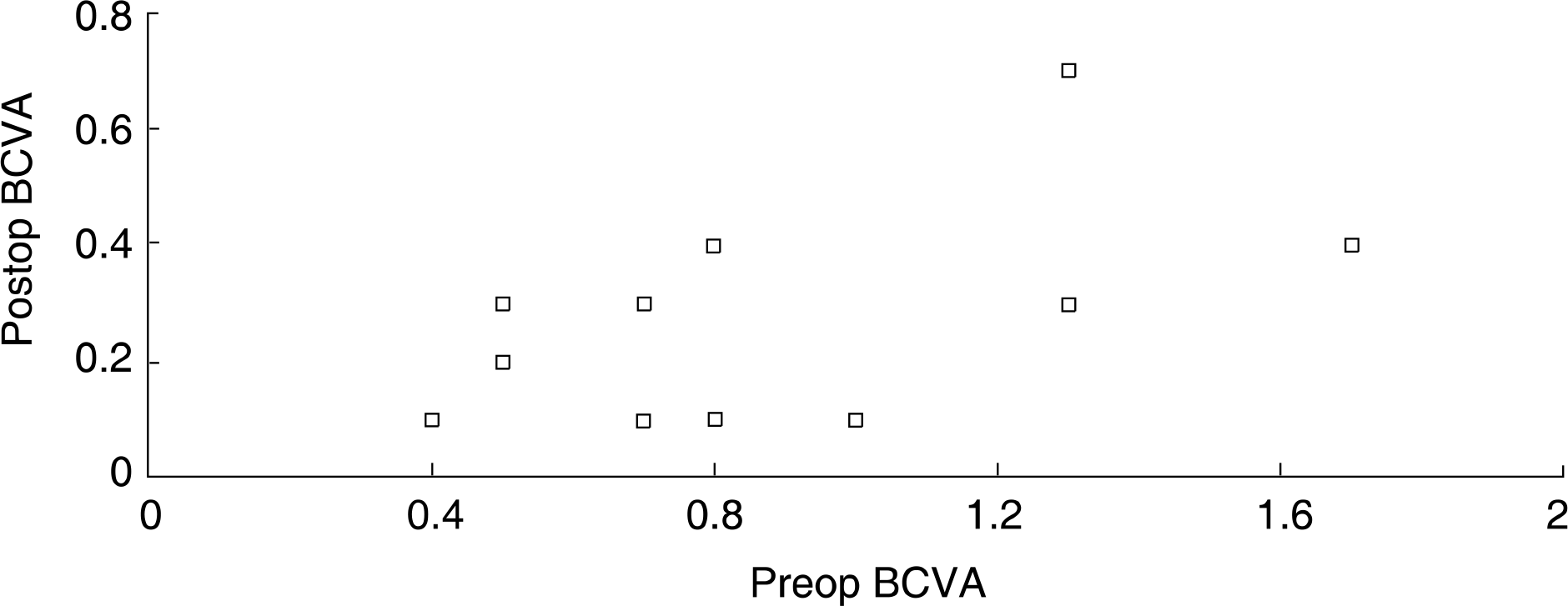Abstract
Purpose
To examine the results of macular hole surgery using pars plana vitrectomy (PPV), triamcinolone-assisted peeling of the internal limiting membrane (ILM), and intravitreous air in idiopathic stage 2 and 3 macular holes.
Methods
Thirteen eyes of 13 consecutive patients with idiopathic macular hole underwent a PPV with triamcinolone-assisted ILM peeling and intravitreous air tamponade. An air-fluid exchange was performed and the patient was asked to maintain a face-down position at home for 4 days. The follow-up period was 6 months or more in all cases. If a significant cataract was present before surgery, a combined phacoemulsification with posterior chamber lens implantation was performed at the time of the macular hole surgery. The closure of the macular hole was determined by biomicroscopy and Optical Coherence Tomography (OCT).
Results
The idiopathic macular hole was closed after the primary operation in all 13 patients. The postoperative visual acuities (0.1 to 0.9) significantly improved from the preoperative visual acuities (0.02 to 0.4) in all eyes. There was no recurrence of the macular hole and there were no adverse effects of the intraoperative use of triamcinolone and ILM peeling during the follow-up period.
Conclusions
This study suggests that triamcinolone-assisted ILM peeling with intravitreous air may be an effective technique for stage 2 and 3 macular holes. This procedure could reduce the face-down position time and improve early visual rehabilitation by using air instead of long-acting gas tamponade.
Go to : 
References
1. Johnson RW, Gass JD. Idiopathic macular hole. Observations, stages of formation, and implications for surgical intervention. Ophthalmology. 1988; 95:917–24.
2. Yoon HS, Brooks HL, Capone A, et al. Ultrastructural features of tissue removed during idiopathic macular hole surgery. Am J Ophthalmol. 1996; 122:67–75.

3. Kelly NE, Wendel RT. Vitreous surgery for idiopathic macular holes. Result of a pilot study. Arch Ophathalmol. 1991; 109:654–9.
4. Wendel RT, Patel AC, Kelly NE, et al. Vitreous surgery for macular holes. Ophthalmology. 1993; 100:1671–6.

5. Thompson JT, Glaser BM, Sjaarda RN, et al. Effects of intraocular bubble duration in the treatment of macular holes by vitrectomy and transforming growth factor-beta 2. Ophthalmology. 1994; 101:1195–200.

6. Glaser BM, Michels RG, Kuppermann BD, et al. Transforming growth factor-beta2 for the treatment of full-thickness macular holes. A prospective randomized study. Ophthalmology. 1992; 99:1162–73.
7. Liggett PE, Skolik SA, Horrio B, et al. Human autologous serum for the treatment of full-thickness macular holes. Ophthalmology. 1995; 102:1071–6.

8. Gauric A, Massin P, paques M. Autologous platelet concentrate for the treatment of full-thickness macular holes. Graefes Arch Clin Exp Ophathalmol. 1995; 233:549–54.
9. Brooks HL Jr. Macular hole surgery with and without internal limiting membrane peeling. Ophthalmology. 2000; 107:1939–48.

10. Kadonosono K, Itoh N, Uchio E, et al. Staining of internal limiting membrane in macular hole surgery. Arch Ophthalmol. 2000; 118:1116–8.

11. Gandorfer A, Messmer EM, Ulbig MW, Kampik A. Indocyanine green selectively stains the internal limiting membrane. Am J Ophthalmol. 2001; 131:387–8.

12. Schmidt JC, Meyer CH, Rodrigues EB, et al. Staining of internal limiting membrane in vitreomacular surgery: a simplified technique. Retina. 2003; 23:263–4.

13. Li K, Wong D, Hiscott P, et al. Trypan blue staining of internal limiting membrane and epiretinal membrane during vitrectomy: visual results and histopathological findings. Br J Ophthalmol. 2003; 87:216–9.

14. Horio N, Horiguchi M, Yamamoto N. Triamcinolone-assisted internal limiting membrane peeling during idiopathic macular hole surgery. Arch Ophthalmol. 2005; 123:96–9.

15. Brooks HL. Macular hole surgery with and without internal limiting membrane peeling. Ophthalmology. 2000; 107:1939–48.

16. Mester V, Kuhn F. Internal limiting membrane removal in the management of full thickness macular holes. Am J Ophthalmol. 2000; 129:769–77.
17. Park DW, Sipperley JO, Sneed SR, et al. Macular hole surgery with internal limiting membrane peeling and intravitreous air. Ophthalmology. 1999; 106:1392–7.
18. Krohn J. Duration of face-down positioning after macular hole surgery: a comparison between 1 week and 3 days. Acta Ophthalmol Scand. 2005; 83:289–92.
19. Sato H, Kawasaki R, Yamashita H. Observation of idiopathic full thickness macular hole closure in early postoperative period as evaluated by optical coherence tomography. Am J Ophthalmol. 2003; 136:185–7.
20. Doh SH, Kim KS, Kim KB, Yoo JS. Comparison of surgical results for idiopathic macular hole: Fluid-gas exchange vs. fluid-air exchange. J Korean Ophthalmol Soc. 2004; 45:451–6.
21. Isomae T, Sato Y, Shimada H. Shortening the duration of prone positioning after macular hole surgery – comparison between 1 week and 1 day prone positioning. Jpn J Ophthalmol. 2002; 46:84–8.
22. Sato Y, Isomae T. Macular hole surgery with internal limiting membrane removal, air tamponade, and 1-day prone positioning. Jpn J Ophthalmol. 2003; 47:503–6.

23. Song BY, Ahn KY, Seo MS. Internal limiting membrane peeling using indocyanine green in vitrectomy for idiopathic macular hole. J Korean Ophthalmol Soc. 2004; 45:444–50.
24. Da Mata AP, Burk SE, Foster RE, et al. Long term follow-up of indocycnine green-assisted peeling of the retinal internal limiting membrane during vitrectomy surgery for idiopathic macular hole repair. Ophthalmology. 2004; 111:2246–53.
25. Lee JE, Oum BS. Macular hole surgery with or without indocyanine green assisted internal limiting membrane peeling. J Korean Ophthalmol Soc. 2003; 44:2553–9.
26. Kwok AK, Lai TY, Man-chan W, Woo DC. Indocyanine green assisted retinalinternal limiting membrane removal in stage 3 or 4 macular hole surgery. Br J Ophthalmol. 2003; 87:71–4.
27. Smiddy WE, Feuer W, Cordahi G. Internal limiting membrane peeling in macular hole surgery. Ophthalmology. 2001; 108:1471–8.

28. Engelbrecht NE, Freeman J, Sternberg Jr P, et al. Retinal pigment epithelial changes after macular hole surgery with indocyanine green-assisted internal limiting membrane peeling. Am J Ophthalmol. 2002; 133:89–94.

29. Gale JS, Proulx AA, Gonder JR, et al. Comparison of the in vitro toxicity ofgreen to that of trypan blue in human retinal pigment epithelium cell cultures. Am J Ophthalmol. 2004; 138:64–9.
Go to : 
Table 1.
Patient characteristics




 PDF
PDF ePub
ePub Citation
Citation Print
Print




 XML Download
XML Download